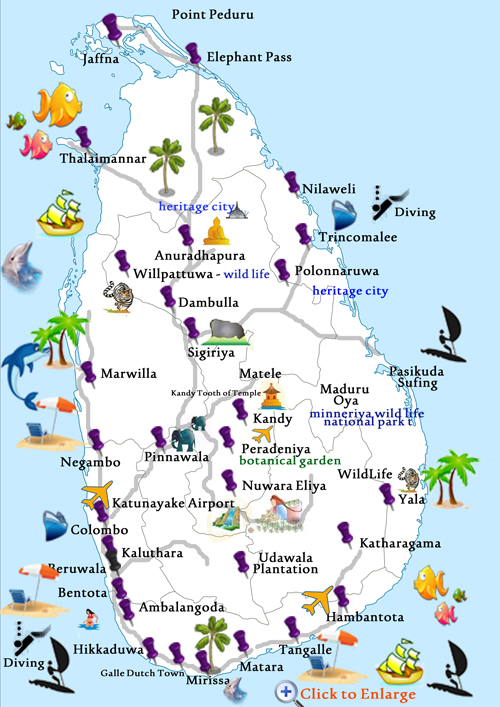



Well – known traveler Marco Polo described Sri Lanka as the “The finest island of its size in the world". Wonderful pristine beaches, lush-green hills, majestic waterfalls, corals, wildlife, heritage sites, pilgrimage sites, exotic cuisine-Sri Lanka has everything that a tourist can imagine. It has something to offer to everyone. The southern half of Sri Lanka is dominated by beautiful and rugged hill country. The entire northern half comprises a large plain extending from the edge of the hill country to the Jaffna peninsula. The best beaches are on the south-western, southern and south-eastern coasts. Temperatures in the low-lying coastal regions are high year round but they rapidly fall with altitude and in the hill country, where it feels like perpetual spring. Rainfall is heaviest in the south, south west and central highlands; the northern and north-central regions are very dry. The best time to visit the west, south coast and hill country is between December and March. May to September is best on the east coast. Animal life is profuse and includes the ubiquitous elephant, as well as leopards, deer, monkeys, sloth bears, wild boar, cobras, crocodiles, dugong and turtles. The island is an important seasonal home to migrating birds, including flamingos, which flock to the lagoons, wetlands and bird sanctuaries for respite from the northern winter. The best time to see birds is between January and April. Visitors who enjoy some mystery and wonderment will marvel at the ancient sites of Anuradhapura, Polonnaruwa, Sigiriya, Dambulla and Panduwasnuwara, where the remains of a great civilization are to be seen. The cities of Colombo and Kandy show the influence of the foreign colonial powers that fought for control over the strategic, lush island in the 16th, 17th and 18th centuries. Dutch-inspired buildings stand cheek to jowl with Victorian British mansions and Portuguese fortifications.

Sri Lanka has a unique climate. Most parts of the country fall under the tropical zone with an average temperature of 27°C, cold here means 23° C and very warm means 32° C, except the highlands of the island, where temperature may drop at night down to 10° C. Here tourists are advised to carry light woolen sweaters, shawls or jackets, for there is a sudden fall of temperature in the evenings. The sea breezes provide a cooling effect around the coastal areas, with its great beaches. A typical Sri Lankan day can be described as- bright, sunny and warm. Climatically, Sri Lanka has no off season. The south west monsoon brings rain mainly from May to July to the western, southern and central regions of the island and an inter-monsoon in October when rain and thunderstorms can occur. Generally, during monsoon the rain will fall for longer periods and will be a little heavier, although this should not stop you from travelling. It would normally only rain for short periods during the afternoon and at night. The north-east monsoon rains occur in the northern and eastern regions in December and January.

Humidity is higher in the southwest and mountainous areas and depends on the seasonal patterns of rainfall. For instance, at Colombo, daytime humidity stays above 70 percent all round the year, even rising to almost 90 percent during the monsoon season in June. Similarly, Anuradhapura experiences a daytime low of 60 percent during the inter-monsoonal month of March, but a high of 79 percent during the later monsoon period in November and December.
From sea level to 7000-foot high national parks, the country has varied geographical and climatic zones. The constantly changing patterns of the countryside is very appealing to the tourists.

The history of Sri Lanka dates back over 2500 years. Its recorded history is traceable to 380 B.C. With the advent of Buddhism in the 3rd century B.C. a civilization rich in Indo-Aryan culture took root. After nearly 500 years of foreign rule (1505-1948) by the Portuguese, the Dutch and the British respectively, Sri Lanka gained independence in February 1948.

Modern Sri Lanka is a multi-lingual, multi-ethnic, multi-religious community of people and enjoy a high quality of life (high literacy and life-expectancy at birth and low infant mortality rates) which are on par with countries in the developed West. This has been attributed to the influence of Buddhism, Ayurveda and the temple-based education over millennia. Sri Lanka is fast becoming the shopping centre of South Asia. Not only that. It is also the ideal venue for meetings, incentive travel, conferences and exhibitions in this part of the world.
